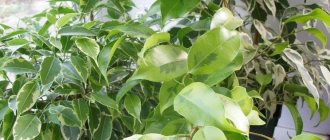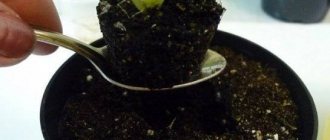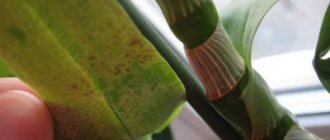Scale insect - a dangerous insect
The small pest is covered with a shield under which thousands of eggs live. Stationary females are tightly attached to the plant with their proboscis and suck out the juices. Males or young individuals migrate, infecting the indoor greenhouse. The shield aphid leaves honeydew - a sweet sticky secretion.
At home, insects breed all year round and do not go into winter dormancy. The appearance of eggs is continuous - 5-6 new generations are formed per year. Colonies quickly destroy indoor flowers.
Peculiarity! Some of the moving larvae (vagrants) enter the apartment with the wind.
Scale insects attack all types of plants, even those that are poisonous to other pests. Favorite species: citrus, palm, bromeliad. Females live equally successfully on orchids, lemons, ficus, ivy, cacti, and crassula.
Kalanchoe leaves dry out and fall off. Problems when growing Kalanchoe
The lush flowering indoor plant Kalanchoe is very popular. The flower is undemanding, has a beautiful appearance and is endowed with healing qualities, which are actively used by traditional healers in the preparation of medicines.
But when growing Kalanchoe, gardeners often encounter serious problems - falling leaves, darkening of the tips of the foliage, the formation of dark spots, etc. All problems, as a rule, are caused by improper care. Although Kalanchoe does not require a scrupulous attitude towards itself, improper care can still cause illness and often the death of the plant.
Read also: Interesting facts and data about fog
Let's look at the most common problems that gardeners face when growing Kalanchoe.
Leaves wither
The first signal to begin active action should be the sluggish state of the flower. The Kalanchoe leaf blade softens, begins to lighten, and a little later falls off.
The reasons for leaf lethargy are the following:
- Excessive watering. Kalanchoe does not require abundant watering; on the contrary, soil moisture should be rare and limited. The leaves of the flower have the ability to accumulate moisture. If watering of the plant is limited, then its leaves are bright, dense and shiny. Overfilling of soil leads to softening of the leaf plate, disruption of the functionality of the root system and a sluggish appearance of the flower.
- Moisture deficiency. Rare and poor soil moisture is also undesirable for Kalanchoe. The leaves of the flower are simply not able to accumulate enough water to last for a long time. If a flower experiences a lack of moisture, its leaves wither, dry out and fall off.
- Watering with the “wrong” water. Moistening the soil (or spraying the foliage) with cold water often leads to lethargic foliage. It is also undesirable to water the plant with ordinary running water. The ideal water for watering Kalanchoe is left to stand for 3 days, at room temperature.
- Sunburn. Bright sunlight hitting the foliage causes burns. The first signs of foliage injury are yellowing and lethargy.
- A sharp change in climatic conditions. If a flower is moved from a warm room to a cold one (and vice versa), this will immediately affect its external condition. Until adaptation takes place, the Kalanchoe will look painful and lethargic.
What you need to know to grow healthy Kalanchoe
Kalanchoe is native to the tropics, which means that it can withstand drought and high humidity equally well. Leaves store moisture and use it during dry periods to survive. In general, the plant is unpretentious. This applies to both watering and fertilizing, lighting and temperatures. But when growing even such hardy flowers, you need to know what to do, how and when.
Landing
The cause of yellowing leaves may be stagnation of moisture.
The first reason for problems with leaves lies in the planting of the flower. For proper development, the plant must initially be planted in a spacious pot.
To prevent excess moisture from stagnating, drainage is necessary. A layer of expanded clay is perfect. If this is not done, there will always be a risk of root rot. The optimal combination of turf and leaf soil with sand in equal proportions. Depleted soil and crowded conditions can lead to disease.
Watering
You need to water once a week - every ten days, with standing water at room temperature. In winter, less often - about once every two weeks. Excess water for Kalanchoe is much more terrible and dangerous than lack. One sign that there is too much moisture is soft leaves. The edges will dry out and turn yellow. The lack of moisture is tolerated much more easily, thanks to its reserves in the leaves.
[adsp-pro-7]
If there is a lack of moisture, the leaves dry out, become thin, and turn yellow. This is a signal that you need to water the flower more often or more abundantly. Kalanchoe will appreciate it if you occasionally bathe it in the shower or spray it with a spray bottle. There is no need to do this in winter. It is useful to wipe the dust with a soft cloth to prevent parasites such as spider mites.
Important! Excess water must be drained! Water in large quantities can provoke the appearance of dangerous bacteria, fungi, diseases and even lead to root rot and death of Kalanchoe.
Selecting a location and temperature
In winter, the plant needs additional lighting
Kalanchoe is not very sensitive to temperature changes. The convenient mode is from +10 to +25 degrees, so the flower can be taken outside or onto the balcony in the spring, where it will be comfortable until the fall. In a Kalanchoe house, a window facing east or west is best suited. There the lighting will not be too intense. For a flowering species, the eastern or southeastern one is preferable.
Additional lighting will also come in handy, especially in winter, when sunlight is in short supply. When there is not enough light, the flower stretches upward, the lower leaves fall off, and the upper ones turn pale. Direct contact with sunlight may cause the leaves to turn red. If the exposure to these rays is too intense, the leaves dry out and die. It is worth changing the place or shading the flower.
In winter, leaves can be damaged by dry hot air. The pot needs to be removed from the radiator and the air humidified.
Scale insect and false scale insect
Scale insects belong to the suborder Coccidae and are insects with an oblong two-millimeter body, which is covered on top with a waxy shield. Females are much larger than males and have neither wings nor legs. They sit motionless, covering their eggs. A plant affected by scale insects is covered with a peculiar coating of insects.
The leaves begin to turn yellow and fall off, the growth of Kalanchoe slows down, and flowering stops. The condition of the plant worsens due to additional damage from sooty fungus, which multiplies in the sticky secretion secreted by scale insects. Pests stay mainly on the underside of leaves. Only young larvae are capable of movement; adults are immobile.
Fighting methods
In order to permanently eliminate the cause of crown drying, as well as return the plant to a fresh, healthy appearance and lush green leaves, it is necessary to take some measures to get rid of this problem:
What to do if Kalanchoe drops its leaves?
Proper watering. This is very easy to do, since Kalanchoe is absolutely unpretentious in this matter. It is worth watering the plant if you notice that the soil is dry. Thus, in the hot season, it is worth moisturizing the flower more often than in winter.
Optimal lighting. The plant does not tolerate direct sunlight, so it is necessary to move it away from the window in case of excess light or do the opposite if there is not enough light.
You should not place Kalanchoe close to window glass, as it reflects the sun's rays and can burn the leaves.
Correct temperature conditions and sufficient air humidity. This criterion is especially important, since dry hot air is detrimental to the plant. In summer, the ideal temperature for the plant is 18-20°C, and in winter – 13-16°C. If the air is very dry, you can use special humidifiers or regularly spray the Kalanchoe with a spray bottle.
By following these recommendations, you can quickly cure Kalanchoe, and the plant will again begin to delight with its blooming appearance.
How to care for a plant
Caring for Kalanchoe is simple and requires compliance with the following rules:
- moderate watering. It is better to underwater a flower than to overwater it. Watering is carried out with settled water at a cool temperature (not higher than room temperature). During the dormant period (after flowering), watering will be minimal;
- The pot should be placed on a sunny windowsill, but without direct sunlight. To achieve flowering, plants must be illuminated for at least 12 hours;
- The optimal temperature for a flower is 17-19 degrees.
By following these simple rules, as well as feeding and replanting Kalanchoe in a timely manner, you will achieve not only its beautiful appearance, but also flowering, as well as the absence of yellow leaves.
What is a mealybug?
The appearance of this pest cannot be confused with anything. This is a fairly large relative of the scale insect. The mealybug reaches up to 8 mm in length.
Female “hairy lice” have an undeveloped oval-shaped body, more typical of insect larvae. They lay numerous eggs in special sacs in the axils of the leaves. The shoots on which the pest lives are covered with a white, sticky waxy coating.
Males are not at all similar to females - they have wings and normally developed limbs, the body is divided into sections and ends in a bunch of tail filaments
Using their mouthparts, females and larvae easily pierce the surface of a leaf, bud or shoot and suck out the juices from it. Young scale insects are extremely mobile and easily move between plants. Sexually mature males do not feed because their mouthparts atrophy as they grow older.
Transfer
Kalanchoe is replanted as needed. The flower grows and develops quickly. For good health, its roots need space: choose each new pot 2 centimeters wider than the previous one. Then the root system will develop properly.
Change the pot to a larger one every year, preferably in the last days of March. This must be done with caution: the trunk, shoots and leaves of the plant are quite fragile. The lump of earth around the root system must be preserved by adding some new soil. Use the same soil as when planting: the same amount of leaf soil, turf soil and sand. Drainage is required.
Love a flower, show it attention and care, devote some of your time and it will more than repay you. It will return the good with its healthy appearance, healing properties or the beauty of its inflorescences.
You can get acquainted with the reasons for the yellowing of Kalanchoe leaves and ways to help the plant from the proposed type of material. Enjoy watching!
Why does Kalanchoe have problems with leaves?
- When there is not enough light , the plant stretches upward, so you need to move it to a brighter room or provide lighting. For the same reason, the lower leaves of Kalanchoe turn yellow and their tips dry out, as can be seen in the photo;
- Stagnant indoor air often causes Kalanchoe leaves to fall off. It is necessary to carry out regular ventilation;
- Spots on the leaves can appear from severe crowding, as well as due to sunburn. It is necessary to place the pots at a considerable distance between them and shade them;
- Kalanchoe stops growing and sheds its leaves due to lack of nutrients, especially after flowering. In this case, you need to transplant the plant into nutrient soil or fertilize it;
- If Kalanchoe leaves curl, it means there is a lot of peat in the soil or an excess of nitrogen. You need to transplant the Kalanchoe into a properly prepared substrate, you can read how to do this here.
- Soft leaves of Kalanchoe and their falling may indicate excessive watering or infection with root rot. It is necessary to reduce watering or carry out appropriate treatment of the root system;
- Excessive direct sunlight can cause the Kalanchoe to turn completely yellow;
- If the Kalanchoe dries out or its leaves wither, this indicates a prolonged lack of watering, the presence of pests in the soil or improper soil composition.
Causes of blackening of Kalanchoe leaves
Why do the leaves of Kalanchoe turn black - it was struck by a fungal infection.
Often the flower suffers from leaf or stem rot, which occurs when there is excess moisture. Increased humidity and stagnation of air in the room contribute to this. Therefore, you need to keep Kalanchoe in a regularly ventilated area. Often fungus occurs due to improper watering. Even if watering is moderate, but water regularly gets on the leaves and shoots of the plant, there is a high risk of infection with rot.
Therefore, it is necessary to water carefully, making sure that the water gets only into the soil and does not wet the ground part of the bush.
Why do leaves fall on Kalanchoe?
All gardeners want Kalanchoe to always please the eye with green leaves. But it happens that the stem of the plant becomes elongated, and the lower leaves begin to turn yellow and fall off. This behavior indicates improper lighting - there is simply not enough sunlight for him. Sometimes this problem occurs after flowering: growth stops, the flower begins to lose leaves. All this happens when Kalanchoe is depleted. He urgently needs a transplant or good feeding.
Leaves also die during the cold season. This happens due to the proximity to central heating. Most likely, the plant is on a windowsill near the radiator, and the air around it is too dry. Move the flower to a room with a lower temperature. The optimal temperature at this time of year is about 13-15 degrees, then the Kalanchoe will overwinter without loss of green mass. The main thing is that at low temperatures there is no excess moisture, otherwise the plant will have to be treated for mold, which manifests itself in the form of black or brown spots.
In general, when caring for Kalanchoe, it is important to trim old shoots in time, then it will delight you for a long time with its beautiful shape and abundant flowering.
Prevention
To avoid Kalanchoe diseases, it is important to follow the recommendations for caring for the flower, do not neglect the conditions of maintenance, and remember that the following are dangerous for the plant:
- drafts;
- drying out the air;
- sudden changes in temperature;
- waterlogging of the soil.
Kalanchoe should be regularly inspected in order to detect diseases or harmful insects in time. A problem noticed at an early stage is easier and faster to eradicate.
Proper care contributes to the normal development of Kalanchoe. In addition, the picky plant requires a minimum of attention:
- Water within reasonable limits . Excessive moisture can only harm the flower. The plant stores moisture for three days. In the cold season, reduced watering is required.
- Maintain a favorable temperature . The norm for Kalanchoe is from +18 to +20 degrees. The flower feels comfortable in a little coolness; heat is more difficult for it to bear.
- Create the required lighting . A bright place, out of direct sunlight, is suitable for a pot of Kalanchoe. The plant needs additional lighting when it blooms.
- Normalize air humidity . When the humidity in the environment is high, fungus and mold appear on the plant.
- The plant is planted in soil suitable for it - infertile soil to which sand and peat are added.
- Add fertilizer in moderation . During the flowering period, Kalanchoe is fed with fertilizers no more than once a week.
Plant value
The plant is valued because it is enriched with extremely useful elements.
In addition to vitamins, microelements, and other valuable substances, flower juice contains:
- flavonoids;
- triterpenoids that inhibit tumor growth;
- bufadienolides, which have antitumor and cardiotonic effects;
- polysaccharides.
Green medicine is valued because its juice can be used immediately, without prior preparation. Can be used for a runny nose, sinusitis, otitis media, eye burns, toothache, and abscesses.
Squeeze the liquid through gauze and immediately drop it into your eyes, nose, and ears. Children need to drop 1-2 drops into each nostril. If the child tolerates it well, then drips should be made every 2 hours. Adults also need to drip into the nose every 2 hours.
After instillation into the nose, severe sneezing may occur. It's okay, that's how the treatment works.
Studies have found that the juice fights staphylococcus and some types of influenza viruses. If you have the flu, you can drop it into your nose and drink 1 tsp of the tincture. a third of a glass of water.
If you are caring for a bedridden patient, then use the nectar of a natural healer to treat bedsores. Bedsores heal even if living tissue dies.
But using fresh nectar can cause a strong burning sensation, so prepare an ointment. Squeeze 30 ml of juice, add 50 g of petroleum jelly and lanolin, stir well. Store the ointment in the refrigerator.
Traditional medicine recommends taking it orally for the treatment of gastritis, tuberculosis, gastrointestinal ulcers, and kidney inflammation. To treat these diseases, a healing elixir prepared from 1 tsp is used. juice to 1/3 cup of water. You should drink twice a day 30 minutes before meals. Course - 3 months. If a person with tuberculosis lives in the house, then drink this remedy for prevention purposes.
Main causes of diseases
Kolanchoe is sick for the following reasons:
- Lack of lighting. Kalanchoe becomes elongated and turns yellow.
- Sunburn or very dense planting. In this case, spotting appears.
- Nutritional deficiency. The flower stops growing and may shed its leaves.
- Excess macronutrients. When a Kalanchoe receives more nitrogen than it needs, its leaves begin to curl.
- Excessive moisture. Leads to acidification of the soil and rotting of the roots.
- Excess sunlight. The plant turns completely yellow.
- The appearance of dry leaves may indicate that the Kalanchoe has not been watered for a long time, the soil has not been selected correctly, or pests have appeared.
Planting and transplanting
One of the factors for the successful development of Kalanchoe at home is timely and proper care. It is especially important to transplant the flower into a new pot.
This houseplant is replanted quite often. This is due to the fact that Kalanchoe has a fast growth rate. This is especially true for the root system. When roots appear above the soil surface, replanting is necessary. Otherwise, the plant will lack nutrients and will soon die.
In addition, a transplant is needed in the following situations:
- severe infection of the flower by insect parasites;
- heavy flooding of the soil, which can lead to rotting of the root system.
Transplantation is carried out at the end of spring. During this period, the flower will be in the stage of active growth, which will allow it to best take root in the new pot and adapt to the new soil. Soil for the plant can be purchased at almost any flower shop. But many gardeners prefer to do it themselves. In this situation, the risk of purchasing a low-quality product that has infested parasites due to improper storage is eliminated.
The transplant is carried out as follows:
- a pot of suitable size is selected. When transplanting, it is taken a little larger than the previous container;
- removing a flower from an old pot with a small amount of soil;
- placing in a new pot and covering the plant with soil.
When planting planting material, the following manipulations are expected:
- preparing soil mixture;
- filling her chosen pot;
- forming a depression in the ground (the same steps must be carried out during transplantation);
- The planting material is slightly deepened and sprinkled with soil on top.
After planting or replanting, the plant should be well watered and optimal conditions should be created for growing it in an apartment. The average survival rate of Kalanchoe is one week. After this, when planting in the pot, new shoots will appear, and when transplanting, new leaves will appear. Both events will indicate that the flower has taken root normally. Please note that during the adaptation period the pot should be fertilized to optimize its nutrition.
Another important aspect of planting and replanting is the formation of a good drainage system at the bottom of the selected pot. It should be done this way: you need to put expanded clay on the bottom of the pot, which will remove excess water and prevent water from stagnating in the soil. Only in such a situation does Kalanchoe adapt as quickly as possible to new growing conditions.
Traditional methods of fighting parasites
Folk remedies will help get rid of scale insects on indoor plants. They are simple, accessible and safe, but are not always effective in cases of large-scale damage. Before using home remedies, be sure to perform mechanical cleaning - this will increase the effectiveness of the procedure.
Folk remedies in the fight against scale insects are presented in the table:
| Means | Cooking method | Application procedure |
| Vinegar | Dissolve 1 tsp. acetic acid in 1 liter of water | Wipe all leaves, sprouts and stems with vinegar solution |
| Washing powder and burdock oil | Add burdock oil and 10 g of washing powder to 1 liter of water. Leave the product for 4 hours | Wipe the leaves with the resulting infusion daily until the pests disappear completely. |
| Pepper | Add 100 g of hot pepper minced in a meat grinder to 2 liters of water and leave for 24 hours | Spray the affected plant generously and repeat the treatment after 10-14 days |
| Alcohol and soap | Mix 1 liter of hot water, 1 tbsp. l. liquid soap and ethyl alcohol. Stir the product until a lush foam forms | Apply the resulting product to places where pests accumulate, and after an hour, rinse with running water. |
| Machine oil and soap | Combine 10 g of liquid soap, 30 ml of water and 10 g of machine oil | Apply the mixture to areas where pests accumulate, and after 12 hours, rinse off in the shower. During processing, cover the soil with polyethylene to avoid contact with the toxic composition. |
| Onion | Chop the onion, add water and leave for several hours | Use the composition to wipe the affected plant |
| Wood ash | Add 300 g of ash to 1 liter of water and boil for 30 minutes. Dilute the finished decoction in 10 liters of water | Use the product to spray the plant after covering the soil with polyethylene |
| Garlic | Chop a few cloves of garlic, add 250 ml of water and leave in a dark place for 6 hours | Moisten a brush or cotton pad in the resulting product and wipe the flower. The composition can be used for spraying, but it must first be filtered through gauze |
Possible plant pests and diseases and ways to combat them
Parasitic insects and diseases can provoke the shedding of Kalanchoe leaves. Let's consider methods for eliminating them.
Aphids on Kalanchoe
Aphids are an insidious pest that become active during the spring season. It is a carrier of more than 100 types of pathogenic microbes. A flower infected with aphids turns yellow and then loses its foliage. In case of severe infection, the death of the plant is not excluded.
Did you know? The inclusion of Kalanchoe in the list of medicinal plants was preceded by a case. In the 60s of the 20th century, a letter came to the Kiev Medical University from a small village, where a resident shared that he had received an unusual plant as a gift that could heal wounds. After this letter, the study of the medicinal properties of Kalanchoe began.
Initially, you may not even suspect the presence of an insect, because it settles on the back side of the leaf plate. But colonies of small green or black individuals that have already settled are easy to see on young shoots and inflorescences. The presence of aphids is also indicated by the sticky mass covering the foliage and stems. Parasites love Kalanchoe juice; they inject a toxin into the plant, thereby poisoning it.
If urgent measures are not taken, the pest can spread to nearby crops. To remove aphids, first remove all affected parts, and treat healthy parts once a week with an insecticide such as Aktara, Iskra, Komandor or Confidor. After a month the problem should be resolved.
The plant can also be cured using a folk remedy such as green potassium soap. To do this, dilute 20 g of soap in 1 liter of water. Wrap the soil in a plastic bag and wash the above-ground part of the plant with soapy water.
Scale insect and false scale insect
The scale insect is a harmful insect with an elongated miniature body covered with a protective waxy shell. Females are larger than males and lack legs and wings.
The false scute is distinguished from the real one by the absence of wax scutes. The eggs and larvae are protected by the drying skin of the dying female.
The pest larvae spread throughout the plant just a few hours after hatching from the eggs. Located on the underside of the leaf blade, the parasite sucks the juices out of it. Adult scale insects and false scale insects are usually motionless, but young ones like to move. Visually, the colonies of this insect look like plaques on Kalanchoe.
The first step is to clean off the parasites. Use a toothbrush for this. It is also recommended to wash the plant with a soap solution, then treat it with an insecticide such as Oxychom, Tsineb, Tiram.
Among non-traditional remedies, wiping with a cloth soaked in diluted alcohol will help (repeat the procedure 3-4 times a week). Garlic infusion, which is based on 5 cloves of vegetable and 200 ml of water, is also effective. The composition should stand in a dark place for 2 hours, after which it must be filtered. The green part is sprayed with this liquid until the scale insects are completely eliminated.
Also read why Kalanchoe leaves turn yellow.
Other pests and diseases
In addition to the above, the flower can be bothered by harmful insects such as mites and mealybugs. The former cover the surface of the leaves with brown scabs. Small glassy specimens can be washed off with soapy water. Then treat the flower with an insecticide (Aktara, Aktofit, Akarin, Fitoverm, Mospilan, Fufanon).
Similar chemicals help against mealybugs, as a result of which the foliage becomes covered with a white waxy coating. Treatment with mineral oils is also effective.
The most dangerous diseases of Kalanchoe that lead to leaf loss are:
- Stem rot. Watery black spots appear on shoots and leaves. If the humidity in the room is excessively high, the disease spreads faster. You can treat the flower with an insecticide. If there is no improvement, the diseased specimen should be disposed of.
- Ring leaf spot. The disease leads to the formation of a mosaic pattern on the leaf blades. Ring spot cannot be cured, so affected areas should be removed.
- Late blight. A fungus that appears as brown spots on the branching area of shoots. They are treated with the use of chemical (“Oxychom”, “Tsineb”, “Tiram”) and biological (“Agat”, “Alirin-B”, “Albit”, “Baktofit”, “Barrier”, “Planzir”, “Trichodermin”) fungicidal drugs. In addition, it is advisable to replace the soil with a new one and reduce watering.
- Powdery mildew. If the foliage is covered with a white powdery coating, then the flower is infected with powdery mildew. In case of inaction, the leaves will inevitably begin to fall. Treatment with fungicides such as “Skor”, “Tilit”, “Topsin”, “Fundazol”, “Quadris” is effective. Natural preparations (Gamair, Planzir, Fitosporin-M) also have a good effect. You can also fight powdery mildew with folk remedies: spray the plant with a mixture of soda ash and soap with soda or wood ash mixed with boiling water and grated laundry soap.
- Gray rot. It appears as a gray coating and weeping spots on the green part. The disease usually spreads to neighboring flowers. Kalanchoe requires treatment with a bacterial preparation (for example, Alirin-B or Planriz). An effective folk remedy is spraying with a solution of potassium permanganate (dilute 2.5 g in 10 liters of water). Perform several applications at intervals of 7–8 days.
Common Pests
- Aphids are the most dangerous enemy of Kalanchoe. Appears mainly in spring. If measures are not taken in time, it will spread to neighboring plants. Aphids are small green or black insects that appear on leaves or stems. She takes the sap of the plant and infects it with her poison. Damaged areas are covered with a sticky substance that prevents the plant from breathing.
At the initial stage, it is difficult to notice the infection, since the insects are very small and settle on the back of the leaf. It can only be detected due to the unhealthy appearance of the plant. It becomes dirty and deformed. To get rid of aphids, you need to trim off the affected areas and burn them. Treat the remaining plant with an insecticide. Repeat once a week for a month. You can also use green potassium soap: dilute it in water and wash the plant with the solution. Can be replaced with laundry soap. Multiclawed mites are small glassy mites. When it appears, the leaves and petioles become covered with brown scabs, and the plant tissues harden and become distorted. Wash off the insects with soapy water and treat the plant with an insecticide.
Scale insects and false scale insects are insects with a two-millimeter body, covered with wax on top. They form a coating (in which sooty fungus is formed) and an accumulation of insects on the plant. The leaves turn yellow, fall off, growth slows down, and flowering stops. For treatment, immediately remove all insects and wash the plant with soapy water. Before removing insects, treat them with alcohol. You can use folk remedies (wipe the plant with a cotton swab and alcohol, use garlic or an old toothbrush).
- Mealybug - an insect that feeds on the sap of Kalanchoe. It propagates the fungus “black mold”. If measures are not taken, the plant will die. The appearance is determined by the appearance of white waxy discharge. For treatment, use mineral oil to spray the leaves.
And this is how leaf diseases and flower pests look in the photo.











